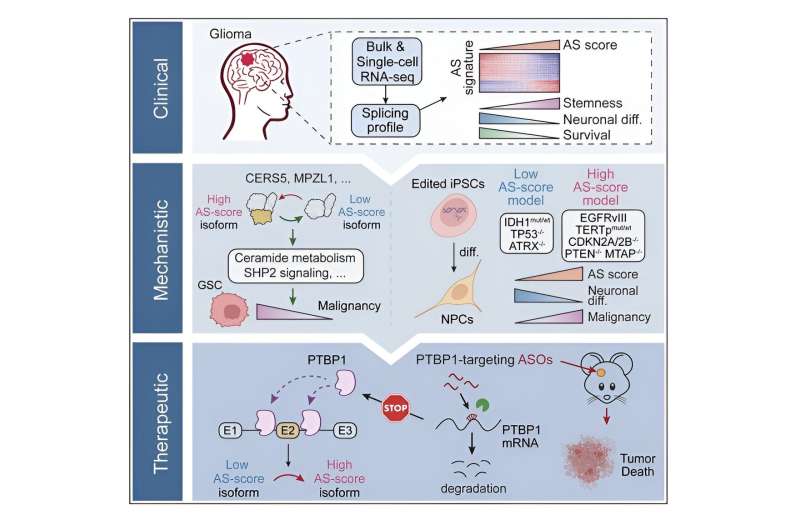This article has been reviewed according to Science X's editorial process and policies. Editors have highlighted the following attributes while ensuring the content's credibility:
fact-checked
peer-reviewed publication
trusted source
proofread
Novel genetic mechanisms may serve as therapeutic target against glioma

A study from the laboratory of Shi-Yuan Cheng, Ph.D., professor in the Ken and Ruth Davee Department of Neurology's Division of Neuro-oncology, has identified novel mechanisms underlying RNA splicing events within glioma tumor cells, mechanisms which may serve as novel therapeutic targets, according to findings published in the Journal of Clinical Investigation.
"We found another way to treat glioma through the alternative splicing perspective, and we found some novel targets which have not been identified before but are important for glioma malignancy," said Xiao Song, MD, Ph.D., research assistant professor of Neurology and lead author of the study.
Gliomas are the most common type of primary brain tumor in adults and originate from glial cells that reside in the central nervous system and support neighboring neurons. Gliomas are highly resistant to standard treatments, including radiation and chemotherapy, due to the tumor's genetic and epigenetic heterogeneity, underscoring the need for new therapeutic targets.
Previous work from the Cheng laboratory, published in Cancer Research, had found that an important splicing factor, SRSF3, is significantly upregulated in gliomas compared with normal brains and SRSF3-regulated RNA splicing promotes the growth and progression of gliomas by affecting multiple cellular processes within the tumor cells.
RNA splicing is a process that involves the removal or "splicing out" of introns (non-coding regions of RNA) and splicing back together exons (coding regions) to form a mature strand of messenger RNA to support gene expression within the cell.
In the current study, the investigators aimed to identify the alternative splicing changes in glioma tumor cells, the mechanisms underlying these alternations, and determine their potential as therapeutic targets.
Using a computational approach and RNA sequencing techniques, the investigators studied splicing changes in glioma tumor cells from patient samples. To validate these splicing changes, the scientists then used CRISPR gene-editing techniques to introduce different glioma driver mutations in human induced pluripotent stem cell (iPSC)-derived glioma models to study the impact of the driver mutations on splicing changes.
They found these splicing changes were enhanced by epidermal growth factor receptor variant III (EGFRIII), which is known to be overexpressed in a variety of tumors including gliomas, and inhibited by the IDH1 genetic mutation.
The investigators then confirmed the function of two RNA splicing events, which generate different protein isoforms with different amino acid sequences.
"Only one of these isoforms can promote tumor growth, unlike the other isoform, which is typically expressed in the normal brain. Tumors leverage this mechanism to selectively express the tumor-promoting isoform over the normal brain isoform," Song said.
Next, the team analyzed upstream RNA binding proteins and discovered that the gene PTBP1 regulates the tumor-promoting RNA splicing in the glioma cells. Using an orthotopic glioma model in immunodeficient mice, the investigators targeted PTBP1 with an antisense oligonucleotide (ASO)-based therapy, which ultimately suppressed tumor growth.
"Our data highlights the role of RNA alternative splicing in impacting glioma malignance and heterogeneity and its potential as a therapeutic vulnerability for treating adult gliomas," the authors wrote.
As for next steps, the investigators are currently working to investigate the potential of targeting PTBP1 to ultimately elicit an anti-tumor immune response, according to Song.
"Through long-read RNA-seq analysis, we discovered that targeting PTBP1 in glioma cells results in the generation of numerous alternatively spliced transcripts that are absent in normal tissues. So, our next project is to see whether this isoform could generate some antigen for the immune system to better recognize the tumor," Song said.
Song also said her team is interested in analyzing splicing changes in non-tumor cells in glioma patients, such as immune cells.
"We already know splicing is very important for the function regulation in the cell, so it should not only regulate the tumor malignancy, but may also regulate the function of the immune cell to determine whether it can effectively kill the cancer. So, we are also doing some bioinformatic analysis in the tumor-infiltrated immune cells to see if there is a splicing change after the immune cell infiltrated the tumor.
"Our goal is to determine the role of alternative splicing in shaping the immune-suppressive tumor microenvironment and identify potential targets to enhance the effectiveness of immunotherapies in glioma," Song said.
More information: RNA splicing analysis deciphers developmental hierarchies and reveals therapeutic targets in adult glioma. Journal of Clinical Investigation (2024). DOI: 10.1172/JCI173789. www.jci.org/articles/view/173789



















